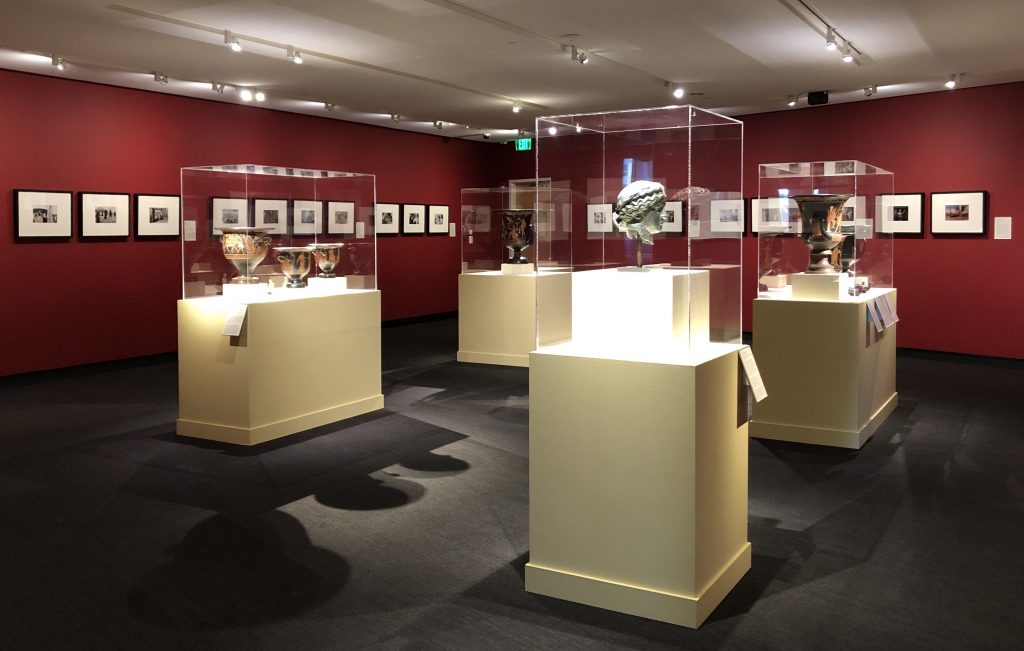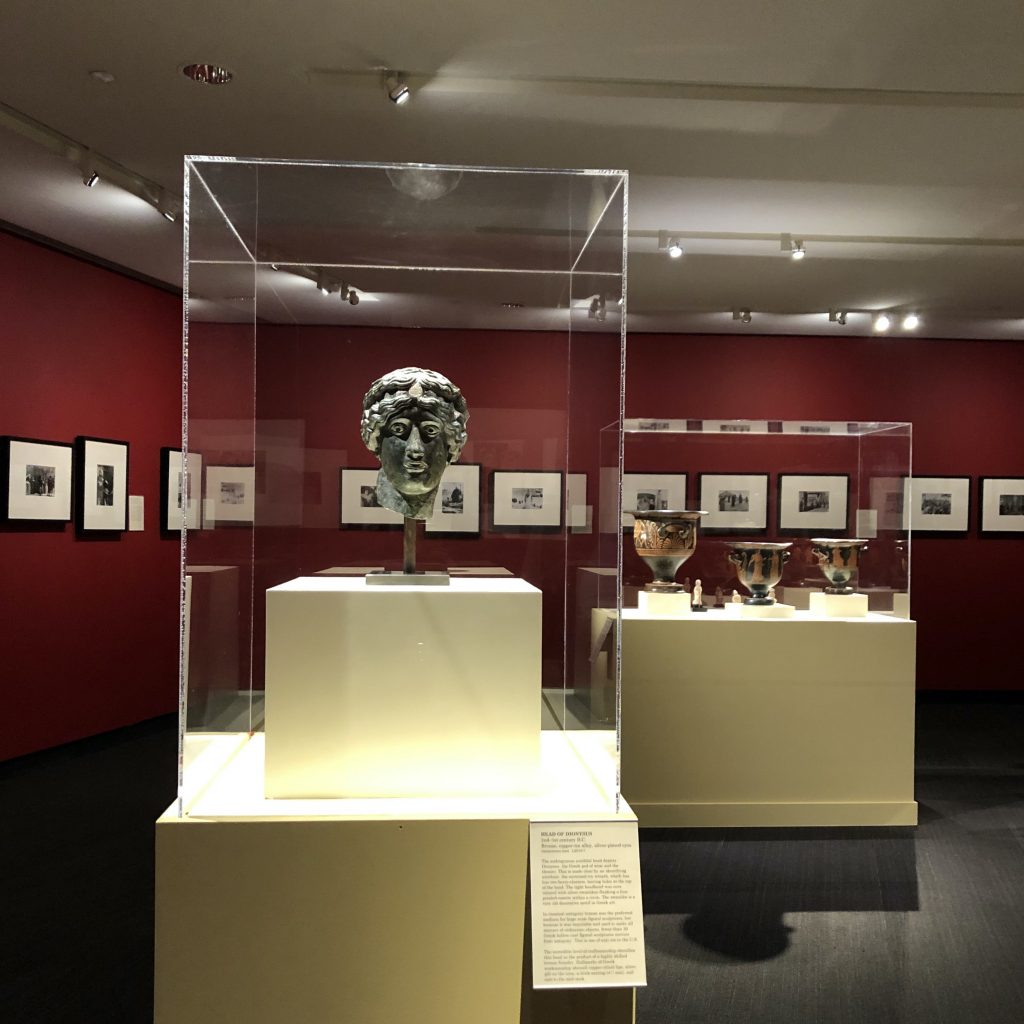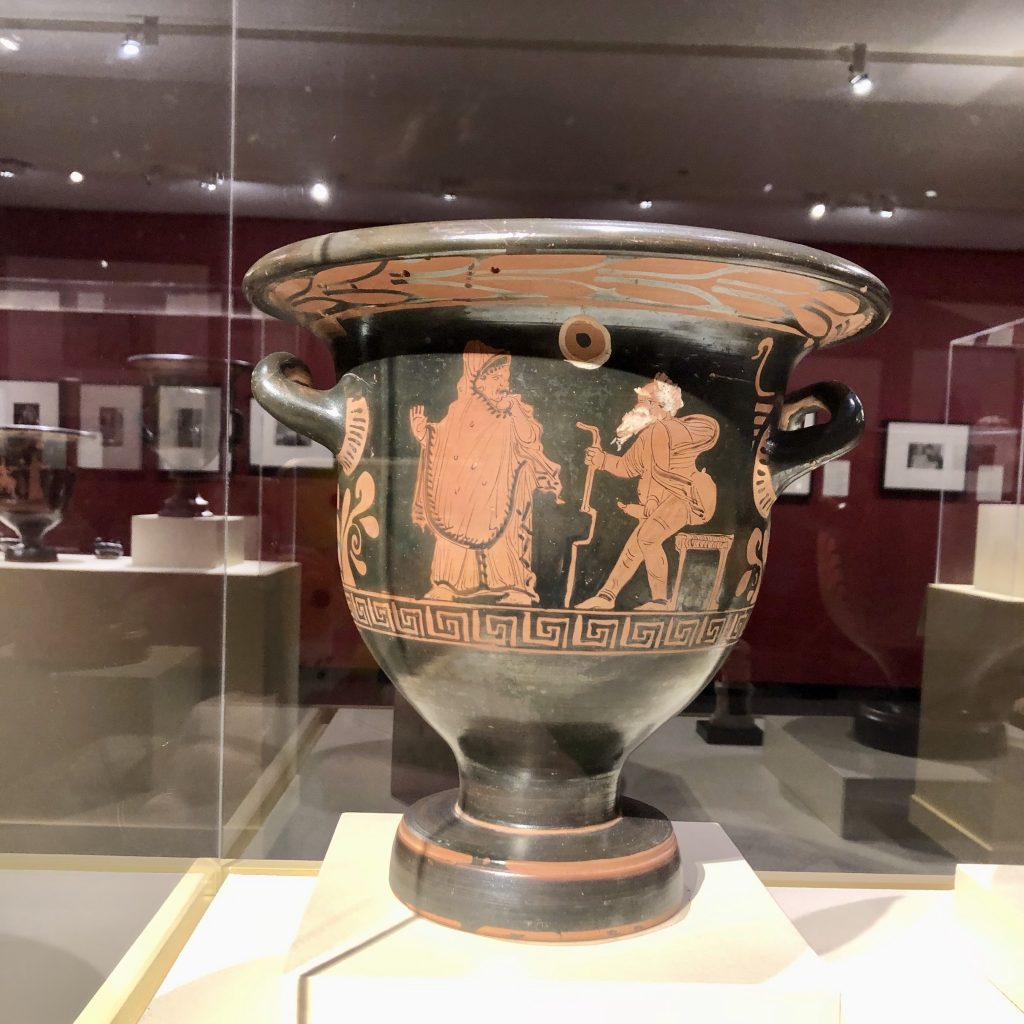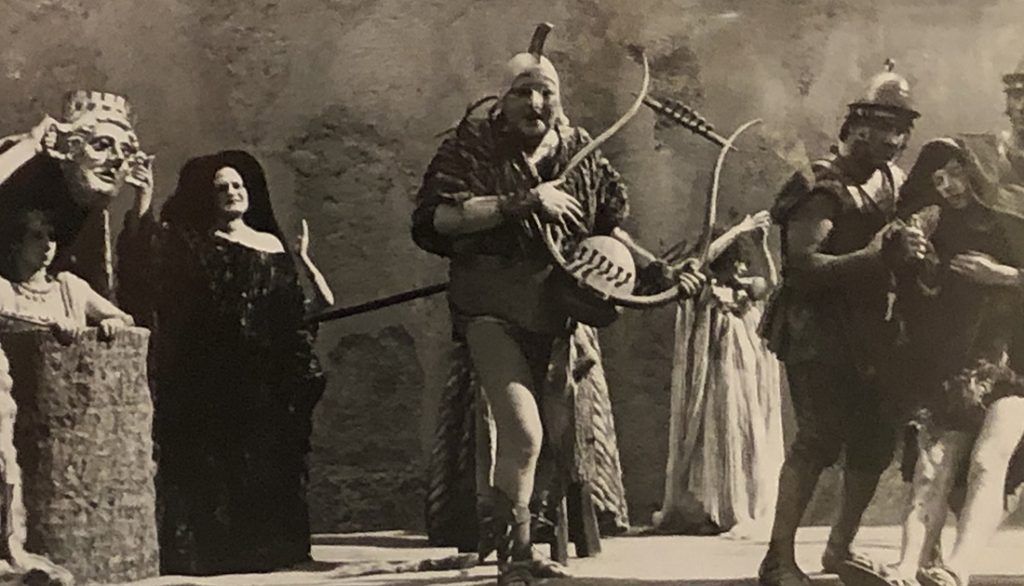By Dr. Bob Bianchi
You may not realize it, but if you’re a movie buff you may be surprised to learn about just how indebted Hollywood is to the civilizations of Greece and Rome. I’m not just talking about the obvious, like Gladiator (2000) or 300 (2006), but about films like the eleven in the Star Wars series. As one critic has perceptibly noted, filmmaker George Lucas admits his indebtedness to Isaac Asimov’s Foundation Trilogy (1951), for which Asimov likewise acknowledges his indebtedness to Edward Gibbon’s Decline and Fall of the Roman Empire (1776). All rely on the binary interaction of benevolent forces of good against malevolent powers of evil, think Caligula (1980).
And that is why I am so enamored of Ancient Theater and the Cinema, on view through April 5th at the Museum of Fine Arts, St. Petersburg, carefully researched and curated by Michael Bennett, Ph.D., Senior Curator of Early Western Art, and mounted to great effect in the intimate, upstairs Works on Paper gallery. This exhibition features magnificent ancient works of art, principal among which are outstanding examples of theater-themed vases from Magna Graecia, as the southern part of the boot of the Italian peninsula was affectionately named in antiquity.

Photo Credit: Courtesy of the Museum of Fine Art St. Peterburg.
Upon entering an environment bathed in a deep red, one is encouraged to follow the prescribed line of march, dictated by the carefully chosen and thematically grouped movie stills, on loan from Tampa’s University of South Florida Special Collections Library, which line the four gallery walls. One looks at the stills, one walks, and one turns only to find a series of exhibition cases conveniently arranged in the center of the gallery with each object in each of those cases presenting its principal side toward the stills. You do not have to walk around the case in an attempt to figure out what to look at first.

2nd – 1st century B.C.
Bronze, copper-tin alloy, silver-plated eyes
Anonymous loan L 2019.7.
Photo Credit: Courtesy of the Museum of Fine Arts St. Petersburg.
And while you may recognize the famous actors and actresses and the productions from which the stills are taken, you will probably be introduced to the theater-themed ancient art for the very first time. So here’s a quick “Theater-themed Ancient Art for Dummies.” Ancient Greek drama developed around the cult of Dionysus, popularly regarded as the god of wine and the party. However, via aspects of his cult’s transformational characteristics, Dionysus became the embodiment of impersonation or role-playing. There is an original Greek, hollow-cast bronze portrait of Dionysus (on anonymous loan) on view in this gallery, one of only six ancient Greek originals in America. Dionysus became the patron of ancient drama, which, as we know it today, was invented in Athens, and consisted of annual competitions with prizes for tragedy and comedy. The trio of award-winning dramatists—Aeschylus, Sophocles, and Euripides—are well known; the authors of comedy, less so. And that comedy evolved from the often very personal and satiric attacks in the comedy of Aristophanes to the phlyax (pronounced fli-ax) plays, derived from the Greek noun meaning gossip players. Introduced during the fourth century BC in Magna Graecia, phlyax plays were basically absurd or ridiculous portrayals of traditional myths and daily life or even satirical burlesques of classical tragedy. Less than a half a dozen of the authors of these plays are known by name, and even less is known about the actual titles of their plays or their plots. Consequently, the depictions of phlyax actors on the vases exhibited in this gallery play a critical role in one’s understanding and assessment of those lost plays. Like those plays, the names of the painters and potters of these vases from Magna Graecia are generally not preserved, so that scholars have traditionally grouped vases which are stylistically similar to one another together, and have named the painter after the most significant example of that group, usually by the name of the collection in which that particular vase is housed.

South Italian, Apulian, c. 375-350 B.C.
Attributed to the Berkeley Painter Ceramic
On loan from the Collection of Willian Knight Zewadski.
Photo Credit: Courtesy of the Museum of Fine Arts St. Petersburg.
A leitmotif, or recurrent theme, of the depiction of those phlyax actors on those vases is an inherent eroticism, suggested by the bawdy, salacious nature of their content. A case in point is the subject matter of a red-figure (so-called because the figures are reserved in the red color of the clay) bell krater, or ancient kind of punch bowl in which wine was mixed with water, attributed to the Berkeley Painter working in the south Italian city of Apulia. The phlyax wears a padded bodysuit emphasizing his pot belly and cellulite buttocks to which has been attached an oversized phallus, which incidentally, is often associated with the aroused, male followers of Dionysus. He holds a crooked cane as he confronts a (male actor in the guise of a) female figure, clothed in a loosely-fitting garment, who gesticulates with her right hand.

Although no phlyax plays have survived, one can gain a vicarious impression of their nature with the screening at the MFA on March 5th from 7-9 pm of Federico Fellini’s Satyricon (1969), based upon the novel of the same name by Petronius (circa 27-66 CE), writing during the reign of the infamous Roman Emperor Nero. (This screening is free to museum members; non-members will be charged the museum admission fee plus an event fee of $5.00.)
The theater stills on view were gifted to the University of South Florida by William Knight Zewadski, who also loaned from his personal collection most of the original antiquities on view in this exhibition. Curator Michael Bennett will interview Bill Zewadski as part of the museum series In the Shade of the Stoa on February 7th, from 11-12 pm. Mr. Zewadski will also present a lecture, Drama in Ancient Greek Pottery with Bill Zewadski, at the Museum on March 10th, from 2-3 pm, in an event which is sponsored by and free for members of the Museum’s Friends of Decorative Arts. (For those who are not, the usual admission plus lecture fees apply. All planning on attending are advised to arrive before 1:45 pm.)
One can only be impressed by the synergy generated by this particular type of programming which enables visitors to confront original works of ancient art in tandem with vintage film stills and select screenings, and made possible in large part by the passion and vision of a local collector.
Dr. Bob Bianchi received his Ph.D. from the Institute of Fine Arts, New York University, after which he served as curator in the Department of Egyptian, Classical, and Ancient Middle Eastern Art at the Brooklyn Museum of Art. During his career he has been the recipient of several post-doctoral fellowships, has subsequently served as a curator in museums in the States, Europe, and the Middle East, has excavated for 17 seasons in Egypt, and has taught as an adjunct professor at three universities. To date, he has published 96 books, 376 journal articles, and book reviews, and has appeared in 96 telecasts worldwide. As a critical art historian with a specialization in Ptolemaic Egypt, he continues to explore intercultural artistic connections between Egypt, Greece, and Rome. He recently retired, as chief curator, after almost twenty years of service with the Foundation Gandur pour l’Art, Genéve. Dr. Bianchi continues to publish, address international congresses, and serve as a fine art advisor and certified appraiser to collectors and institutions. He can be reached at thedrbob@verizon.net.
ANCIENT THEATER AND THE CINEMA is on view at the Museum of Fine Arts, St. Petersburg in downtown St. Petersburg, FL, through Sunday, April 5, 2020.
RELATED PROGRAMMING
Friday, February 7, 11 am- 12:00 pm
In the Shade of the Stoa with Dr. Michael Bennett — Theater in the Classical World with Bill Zewadski
Free with Museum admission
Thursday, March 5, 7–9 pm
Ancient Theater and the Cinema Film Series
Satyricon (1969)
Cost: $5, plus Museum admission
From the Museum’s website: Petronius’ Satyricon, written during the reign of the emperor Nero and set in imperial Rome, inspired Fellini’s 1969 Italian fantasy. The film is divided into nine episodes, following the scholar Encolpius and his friend Ascyltus as they try to win the heart of the young boy Gitón, whom they both love, within the film’s depiction of a surreal and dreamlike Roman landscape and culture. Vincent Canby of The New York Times noted that Satyricon was “the quintessential Fellini film, a travelogue through an unknown galaxy, a magnificently realized movie of his and our wildest dreams.”
Tuesday, March 10, 2-3 pm
Friends of the Decorative Arts Lecture Series
Drama in Ancient Greek Pottery with Bill Zewadski
$10, plus Museum admission; $10 for MFA members; and free for MFA Friends of Decorative Arts members.
Complimentary coffee and cookies.
Doors for the lecture do not open until 1:45 pm.
Early attendees are invited to view the gallery.

